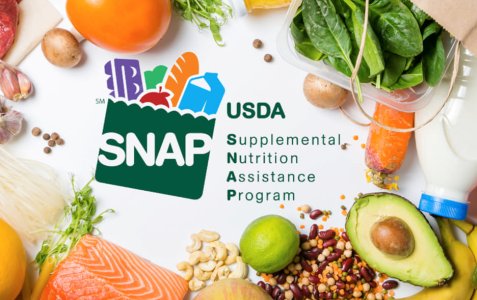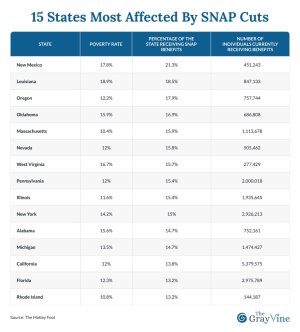SNAP reductions may impact seniors the most in these 15 states
- Replies 3
Many older Americans rely on a certain program just to get by.
For those without much income—or any retirement savings—this monthly support often determines whether they eat at all.
But looming policy changes could soon alter that, and some locations are expected to suffer more than others.
Federal cuts to SNAP—short for the Supplemental Nutrition Assistance Program—are likely to affect every state.
But 15 states may be hit especially hard, based on the percentage of residents who rely on the program for food assistance.
The cuts are part of President Trump’s recently passed Big Beautiful Bill Act, which includes nearly $300 billion in reductions to SNAP through 2034.
While the plan includes tax breaks for individuals and corporations, it also shifts SNAP costs to the states—requiring them to pay 5% to 25% of food benefit costs, depending on their payment error rates.
That cost shift is already creating strain. For example, New Mexico may need to find an extra $268 million just to maintain current benefit levels.
According to the House Agricultural Committee, around 8 million Americans aged 60 and up rely on SNAP for access to healthy food.
Roughly 85% of those seniors live alone, and more than half report little to no income.
Many depend entirely on Supplemental Security Income (SSI) or other general assistance.
And although the SNAP cuts won’t begin until after the 2026 midterm elections, states must begin budgeting soon.
This is causing officials to scramble, with no clear plan for how to make up the lost federal support.
The 15 states facing the greatest impact from the SNAP cuts include:
What makes the situation even more difficult is the uncertainty surrounding how states will handle the shortfall. Most states are not currently equipped to shoulder additional SNAP costs on top of deep cuts to Medicaid.
And this isn’t just about benefits. According to The Commonwealth Fund, roughly 143,000 jobs are expected to be lost nationwide as a result of the SNAP cuts.
This includes 78,000 jobs in food-related industries, such as agriculture, food processing, and grocery retail.
By 2026, it’s estimated that state and local tax revenues could fall by $1.8 billion due to reduced SNAP spending.
For those affected, here are five steps to take if you receive a notice about reduced SNAP benefits:

How do you feel about the states being left to handle the fallout from federal SNAP cuts? Are you or someone you know preparing for potential changes? Let us know in the comments.
For those without much income—or any retirement savings—this monthly support often determines whether they eat at all.
But looming policy changes could soon alter that, and some locations are expected to suffer more than others.
Federal cuts to SNAP—short for the Supplemental Nutrition Assistance Program—are likely to affect every state.
But 15 states may be hit especially hard, based on the percentage of residents who rely on the program for food assistance.
The cuts are part of President Trump’s recently passed Big Beautiful Bill Act, which includes nearly $300 billion in reductions to SNAP through 2034.
While the plan includes tax breaks for individuals and corporations, it also shifts SNAP costs to the states—requiring them to pay 5% to 25% of food benefit costs, depending on their payment error rates.
That cost shift is already creating strain. For example, New Mexico may need to find an extra $268 million just to maintain current benefit levels.
According to the House Agricultural Committee, around 8 million Americans aged 60 and up rely on SNAP for access to healthy food.
Roughly 85% of those seniors live alone, and more than half report little to no income.
Many depend entirely on Supplemental Security Income (SSI) or other general assistance.
And although the SNAP cuts won’t begin until after the 2026 midterm elections, states must begin budgeting soon.
This is causing officials to scramble, with no clear plan for how to make up the lost federal support.
The 15 states facing the greatest impact from the SNAP cuts include:
What makes the situation even more difficult is the uncertainty surrounding how states will handle the shortfall. Most states are not currently equipped to shoulder additional SNAP costs on top of deep cuts to Medicaid.
And this isn’t just about benefits. According to The Commonwealth Fund, roughly 143,000 jobs are expected to be lost nationwide as a result of the SNAP cuts.
This includes 78,000 jobs in food-related industries, such as agriculture, food processing, and grocery retail.
By 2026, it’s estimated that state and local tax revenues could fall by $1.8 billion due to reduced SNAP spending.
For those affected, here are five steps to take if you receive a notice about reduced SNAP benefits:
- Read the letter carefully. It should explain why your benefits are being reduced or cut.
- Look for mistakes. Check for any errors in income reporting or household size.
- Report any changes. If your income, expenses, or living situation has changed, report it.
- File an appeal. If you believe the decision is wrong, you have the legal right to request a hearing.
- Find local resources. Food banks and programs like the Senior Farmers’ Market Nutrition Program can help bridge the gap.
- SNAP benefits just expanded in these two states—Find out if you qualify!
- Your favorite restaurants could soon accept SNAP benefits—here’s what you need to know!
Key Takeaways
- SNAP cuts from the Big Beautiful Bill Act could affect over 900,000 residents in 15 high-dependency states.
- Seniors aged 60+ make up a significant portion of SNAP recipients, with 85% living alone and over half having no income.
- States will now be required to pay 5% to 25% of SNAP benefit costs, depending on error rates.
- Nearly 143,000 jobs may be lost and state/local tax revenue could decline by $1.8 billion in 2026 due to reduced SNAP funding.








